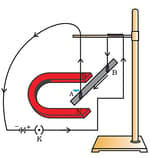Mizoram Board Solutions for Chapter: Magnetic Effects of Electric Current, Exercise 4: QUESTIONS
Mizoram Board Science Solutions for Exercise - Mizoram Board Solutions for Chapter: Magnetic Effects of Electric Current, Exercise 4: QUESTIONS
Attempt the free practice questions on Chapter 13: Magnetic Effects of Electric Current, Exercise 4: QUESTIONS with hints and solutions to strengthen your understanding. SCIENCE TEXTBOOK FOR CLASS X solutions are prepared by Experienced Embibe Experts.
Questions from Mizoram Board Solutions for Chapter: Magnetic Effects of Electric Current, Exercise 4: QUESTIONS with Hints & Solutions
Which of the following property of a proton can change while it moves freely in a magnetic field?
Take a small aluminium rod AB (of about ). Using two connecting wires suspend it horizontally from a stand, as shown in Fig.
Place a strong horse-shoe magnet in such a way that the rod lies between the two poles with the magnetic field directed upwards. For this put the north pole of the magnet vertically below and south pole vertically above the aluminium rod. Connect the aluminium rod in series with a battery, a key, and a rheostat. Now pass a current through the aluminium rod from end B to end A. What do you observe? It is observed that the rod is displaced towards the left. You will notice that the rod gets displaced. Reverse the direction of current flowing through the rod and observe the direction of its displacement. It is now towards the right. Why does the rod get displaced?

In above activity, how do we think the displacement of rod AB will be affected if (i) current in rod AB is increased; (ii) a stronger horse-shoe magnet is used and (iii) length of the rod AB is increased?
A positively-charged particle (alpha-particle) projected towards the west is deflected towards the north by a magnetic field. The direction of the magnetic field is
